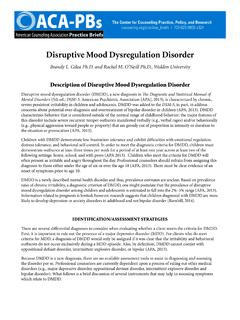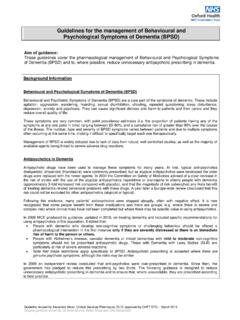Transcription of Canadian Network for Mood and Anxiety Treatments …
1 bipolar disorders . 2018;20:97 170. | 97 2018 John Wiley & Sons A/S. Published by John Wiley & Sons Ltd DOI: ARTICLEC anadian Network for Mood and Anxiety Treatments (CANMAT) and International Society for bipolar disorders (ISBD) 2018 guidelines for the management of patients with bipolar disorderLakshmi N Yatham1 | Sidney H Kennedy2 | Sagar V Parikh3 | Ayal Schaffer2 | David J Bond4 | Benicio N Frey5 | Verinder Sharma6 | Benjamin I Goldstein2 | Soham Rej7 | Serge Beaulieu7 | Martin Alda8 | Glenda MacQueen9 | Roumen V Milev10 | Arun Ravindran2 | Claire O Donovan8 | Diane McIntosh1 | Raymond W Lam1 | Gustavo Vazquez10 | Flavio Kapczinski5 | Roger S McIntyre2 | Jan Kozicky11 | Shigenobu Kanba12 | Beny Lafer13 | Trisha Suppes14 | Joseph R Calabrese15 | Eduard Vieta16 | Gin Malhi17 | Robert M Post18 | Michael Berk191 Department of Psychiatry, University of British Columbia, Vancouver, BC.
2 Canada2 Department of Psychiatry, University of Toronto, Toronto, ON, Canada3 Department of Psychiatry, University of Michigan, Ann Arbor, MI, USA4 Department of Psychiatry, University of Minnesota, Minneapolis, MN, USA5 Department of Psychiatry and Behavioural Neurosciences, McMaster University, Hamilton, ON, Canada6 Departments of Psychiatry and Obstetrics & Gynaecology, Western University, London, ON, Canada7 Department of Psychiatry, McGill University, Montreal, QC, Canada8 Department of Psychiatry, Dalhousie University, Halifax, NS, Canada9 Department of Psychiatry, University of Calgary, Calgary, AB, Canada10 Departments of Psychiatry and Psychology, Queen s University, Kingston, ON, Canada11 School of Population and Public Health, University of British Columbia, Vancouver, BC, Canada12 Department of Neuropsychiatry, Kyushu University, Fukuoka, Japan13 Department of Psychiatry, University of Sao Paulo, Sao Paulo, Brazil14 bipolar and Depression Research Program, VA Palo Alto, Department of Psychiatry & Behavioral Sciences Stanford University, Stanford, CA, USA15 Department of Psychiatry, University Hospitals Case Medical Center, Case Western Reserve University, Cleveland, OH, USA16 bipolar Unit, Institute of Neuroscience, Hospital Clinic, University of Barcelona, IDIBAPS, CIBERSAM, Barcelona, Catalonia.
3 Spain17 Department of Psychiatry, University of Sydney, Sydney, NSW, Australia18 Department of Psychiatry, George Washington University, Washington, DC, USA19 Deakin Univeristy, IMPACT Strategic Research Centre, School of Medicine, Barwon Health, Geelong, Vic., AustraliaCorrespondenceLakshmi N Yatham, Department of Psychiatry, University of British Columbia, Vancouver, BC, : | YATHAM eT | INTRODUCTIONIn the 20 years since the Canadian Network for Mood and Anxiety Treatments (CANMAT) first published guidelines on the management of BD (BD),1 there has been an explosion of research on treatment of this illness. During this time period, CANMAT has strived to translate advances in research into international consensus on evidence- based clinical management; first by publishing 2005 guidelines accompanied by expert commentaries, then by providing updates in 2007,2 20093 and 20134 in collaboration with the International Society for bipolar disorders (ISBD).
4 The main objective of these publications was to syn-thesize the wealth of evidence on the efficacy, safety, and tolerability of the range of interventions available for this complex and varied ill-ness, with the goal of providing clear, easy to use recommendations for clinicians to improve outcomes in their that 13 years have elapsed since the publication of the last full edition in 2005, the objective of these 2018 CANMAT and ISBD bipolar Disorder Management Guidelines is to provide a compre-hensive, up-to-date review of research evidence on the treatment of various phases of BD, translated into clinical recommendations for evidence- based management.
5 Updated principles related to di-agnosis and management are also included, in response to signif-icant changes made in the 5th edition of the American Psychiatric Association Diagnostic and Statistical Manual for Mental disorders The Canadian Network for Mood and Anxiety Treatments (CANMAT) previously pub-lished treatment guidelines for bipolar disorder in 2005, along with international com-mentaries and subsequent updates in 2007, 2009, and 2013. The last two updates were published in collaboration with the International Society for bipolar disorders (ISBD). These 2018 CANMAT and ISBD bipolar treatment Guidelines represent the significant advances in the field since the last full edition was published in 2005, includ-ing updates to diagnosis and management as well as new research into pharmacologi-cal and psychological Treatments .
6 These advances have been translated into clear and easy to use recommendations for first , second, and third- line Treatments , with consid-eration given to levels of evidence for efficacy, clinical support based on experience, and consensus ratings of safety, tolerability, and treatment - emergent switch risk. New to these guidelines, hierarchical rankings were created for first and second- line treat-ments recommended for acute mania, acute depression, and maintenance treatment in bipolar I disorder. Created by considering the impact of each treatment across all phases of illness, this hierarchy will further assist clinicians in making evidence- based treatment decisions.
7 Lithium, quetiapine, divalproex, asenapine, aripiprazole, paliperi-done, risperidone, and cariprazine alone or in combination are recommended as first- line Treatments for acute mania. First- line options for bipolar I depression include quetiapine, lurasidone plus lithium or divalproex, lithium, lamotrigine, lurasidone, or adjunctive lamotrigine. While medications that have been shown to be effective for the acute phase should generally be continued for the maintenance phase in bipolar I disorder, there are some exceptions (such as with antidepressants); and available data suggest that lithium, quetiapine, divalproex, lamotrigine, asenapine, and aripiprazole monotherapy or combination Treatments should be considered first-line for those ini-tiating or switching treatment during the maintenance phase.
8 In addition to addressing issues in bipolar I disorder, these guidelines also provide an overview of, and recom-mendations for, clinical management of bipolar II disorder, as well as advice on specific populations, such as women at various stages of the reproductive cycle, children and adolescents, and older adults. There are also discussions on the impact of specific psy-chiatric and medical comorbidities such as substance use, Anxiety , and metabolic disor-ders. Finally, an overview of issues related to safety and monitoring is provided. The CANMAT and ISBD groups hope that these guidelines become a valuable tool for prac-titioners across the globe. | 99 YATHAM eT Al.(DSM- 5).
9 5 With increased research into various Treatments for BD, the evidence ratings have also been modified to increase rigor; for instance, minimum sample sizes are now specified for randomized controlled trials (RCTs) at each level of evidence (Table 1).As with previous editions of CANMAT guidelines, clinical support for efficacy was an important consideration in arriving at the final treatment recommendations (Table 2). Major conflicting data are ad-dressed in blue text boxes (figures) to clarify the rationale for arriving at a specific level of evidence for the current edition, an additional distinction is made between safety and tolerability, and a consensus rating is assigned to each medication on these two measures when used in both the acute and maintenance phase.
10 Further, a rating is also assigned to each medication for its propensity to switch patients into mania or de-pression ( treatment -emergent switch). More information on these ratings can be found in the respective treatment sections, as well as in Section final grading of recommendations into first, second, or third- line considers levels of evidence for efficacy, clinical support based on experience, and consensus ratings of safety, tolerability, and risk of treatment - emergent switch. In addition, hierarchical rankings were created and are listed in the tables for first and second line recom-mendations for acute mania, depression and maintenance treatment in bipolar I disorder (BDI).




